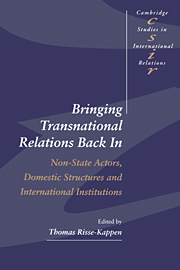 Bringing Transnational Relations Back In
Bringing Transnational Relations Back In Book contents
- Frontmatter
- Contents
- List of tables
- List of contributors
- Preface
- List of abbreviations
- Setting the agenda
- Case studies
- Conclusions: So what?
- 8 Power politics, institutions, and transnational relations
- 9 Structures of governance and transnational relations: what have we learned?
- Index
- CAMBRIDGE STUDIES IN INTERNATIONAL RELATIONS
9 - Structures of governance and transnational relations: what have we learned?
Published online by Cambridge University Press: 02 December 2009
- Frontmatter
- Contents
- List of tables
- List of contributors
- Preface
- List of abbreviations
- Setting the agenda
- Case studies
- Conclusions: So what?
- 8 Power politics, institutions, and transnational relations
- 9 Structures of governance and transnational relations: what have we learned?
- Index
- CAMBRIDGE STUDIES IN INTERNATIONAL RELATIONS
Summary
The chapters in this volume demonstrate that transnational relations matter in world politics and that we cannot explain state behavior in crucial issue-areas without taking the cross-boundary activities of non-state actors into account. Matthew Evangelista and Patricia Chilton illustrate, for example, that transnational relations contributed to the change in Soviet security policy and to the transformation processes in Eastern Europe and, thus, to the end of the Cold War. David Cameron argues that institutionalized transnational and trans-governmental actors were crucial in the negotiations leading to the treaty on European Economic and Monetary Union (EMU) which is supposed to institute a common currency in Europe by the end of the decade.
But the chapters in this volume also show that there are important limits to the impact of even powerful transnational actors. Cal Clark and Steve Chan show that the contribution of multinational corporations (MNCs) to economic growth in East Asia depends on state strength in conjunction with a Confucian culture. Peter Katzenstein and Yutaka Tsujinaka demonstrate that American MNCs needed support from the US state in order to penetrate Japanese markets. Matthew Evangelista shows that the impact of US-Russian transnational coalitions on Russian arms control policy decreased when the country's domestic structure changed. Thomas Princen argues that the success of environmental International Non-Governmental Organizations (INGOs) might sometimes be counter-productive for their goals, if they neglect the domestic conditions in their “target states.” In sum, this volume does not confirm some arguments of the earlier debate on transnational relations that interdependence among societies is becoming all-pervasive thereby diminishing the role of the state in international relations.
- Type
- Chapter
- Information
- Bringing Transnational Relations Back InNon-State Actors, Domestic Structures and International Institutions, pp. 280 - 313Publisher: Cambridge University PressPrint publication year: 1995
- 18
- Cited by


